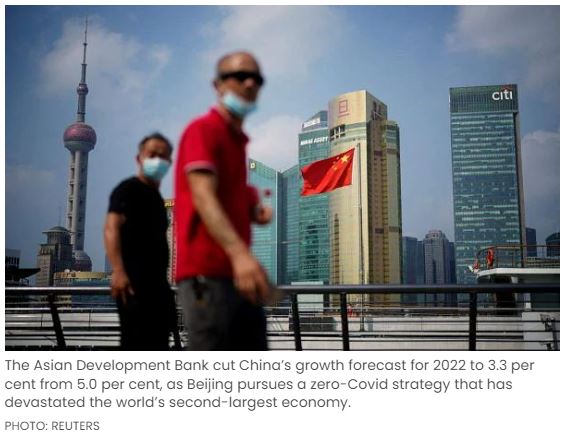ADB raises Asean growth forecast for 2022, but cuts 2023 outlook on worsening outlook
THE Asian Development Bank (ADB) has revised up its 2022 growth projection for South-east Asia to 5.1 per cent from 4.9 per cent, as stronger forecasts for Indonesia, Myanmar and the Philippines offset downward revisions for Singapore and Thailand.
In an update of the Asian Development Outlook 2022, released on Wednesday morning (Sep 21), ADB said consumer spending in Indonesia, Myanmar and the Philippines accelerated after their borders reopened.
“Robust domestic demand is benefiting Indonesia and the Philippines, while higher global commodity prices and dimmer global economic prospects are denting consumer and business sentiment in Singapore and Thailand,” the report said.
Growth projections for this year for Laos, Singapore, Thailand and Timor-Leste have been revised downwards because of weaker external demand from major economies, which will dampen growth in these 4 economies. The forecasts for Brunei, Cambodia, Malaysia and Vietnam are unchanged.
The 2023 growth forecast for South-east Asia, however, has been revised down slightly to 5 per cent from 5.2 per cent, on expectations of weaker global growth, supply chain disruptions, continuing coronavirus lockdowns in China and higher inflation.
Inflation forecast for South-east Asia has been revised higher to 5.2 per cent for 2022 and 4.1 per cent for 2023. This is driven by higher food and energy prices, especially in Indonesia, Thailand and the Philippines, as well as the region’s other larger economies.
Rising import prices because of currency depreciations against the US dollar are also clouding South-east Asia’s inflation outlook, especially in Laos, Myanmar and other smaller economies. Malaysia is the exception as government subsidies and price controls on oil and basic food products have led to a downward revision to the inflation forecast for 2022.
Looking at the wider developing Asia, growth is now projected at 4.3 per cent for this year, and at 4.9 per cent for next year, the ADB said. Developing Asia refers to the ADB’s 46 members, which stretches from the Cook Islands in the Pacific to Kazakhstan in Central Asia.
“Since our April outlook, various headwinds have strengthened,” said the bank’s chief economist Albert Park.
While most countries have started to relax their Covid-19 restrictions, the impact from Russia’s protracted war against Ukraine, aggressive monetary tightening in advanced economies, and repeated lockdowns in China are increasingly clouding the outlook.
Excluding China, the rest of developing Asia is projected to grow by 5.3 per cent both this year and next, making it the first time in more than 3 decades that the rest of developing Asia will grow faster than mainland China.
Inflation forecast has been raised to 4.5 per cent for 2022 from 3.7 per cent, and to 4 per cent for 2023.
ADB president Masatsugu Asakawa said: “While remittances remain healthy and tourism is recovering, signs of a slowdown are emerging, evidenced by weaker export orders and worsening financial conditions.”
Park noted that several downside risks loom large. These include a sharp deceleration in global growth, stronger-than-expected monetary policy tightening in advanced economies, the war in Ukraine escalating, a deeper-than-expected deceleration in China, and negative pandemic developments could all dent developing Asia’s growth over the forecast horizon.
Digital entrepreneurship, which helped keep economies afloat during the pandemic, can become a major engine of growth and job creation in the post-pandemic world, but there is room for improvement, Park added. With the exception of Singapore and South Korea, most of the region’s economies are lagging behind when it comes to the environment for digital entrepreneurs.
According to ADB’s Global Index of Digital Entrepreneurship Systems, Singapore has the world’s best digital environment and support system for entrepreneurs among 113 economies.
The city-state scored 81.3 out of a 100. The US came in second at 79.7 and Sweden third at 79.6. South Korea is ranked 11th at 54.1, with Malaysia at 43.1 and China at 35.3. The index takes into account the level of digitalisation in 8 areas: culture, institutions, market conditions, infrastructure, human capital, knowledge, finance and networking.
Source: https://www.businesstimes.com.sg/asean-business/adb-raises-asean-growth-forecast-for-2022-but-cuts-2023-outlook-on-worsening-outlook


 English
English




